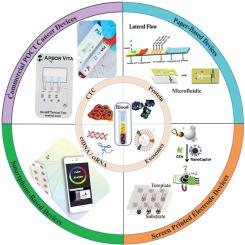Talanta ( IF 5.6 ) Pub Date : 2020-12-21 , DOI: 10.1016/j.talanta.2020.122002 Leila Syedmoradi , Michael L. Norton , Kobra Omidfar

|
Early and timely diagnosis of cancer plays a decisive role in appropriate treatment and improves clinical outcomes, improving public health. Significant advances in biosensor technologies are leading to the development of point-of-care (POC) diagnostics, making the testing process faster, easier, cost-effective, and suitable for on-site measurements. Moreover, the incorporation of various nanomaterials into the sensing platforms has yielded POC testing (POCT) platforms with enhanced sensitivity, cost-effectiveness and simplified detection schemes. POC cancer diagnostic devices provide promising platforms for cancer biomarker detection as compared to conventional in vitro diagnostics, which are time-consuming and require sophisticated instrumentation, centralized laboratories, and experienced operators. Current innovative approaches in POC technologies, including biosensors, smartphone interfaces, and lab-on-a-chip (LOC) devices are expected to quickly transform the healthcare landscape. However, only a few cancer POC devices (e.g. lateral flow platforms) have been translated from research laboratories to clinical care, likely due to challenges include sampling procedures, low levels of sensitivity and specificity in clinical samples, system integration and signal readout requirements. In this review, we emphasize recent advances in POC diagnostic devices for cancer biomarker detection and discuss the critical challenges which must be surmounted to facilitate their translation into clinical settings.
中文翻译:

即时护理癌症诊断设备:从学术研究到临床翻译
癌症的早期及时诊断在适当的治疗中起着决定性的作用,并改善临床结果,改善公共卫生。生物传感器技术的重大进步正导致即时诊断(POC)诊断的发展,使测试过程更快,更容易,更具成本效益并适合于现场测量。此外,将各种纳米材料结合到传感平台中已产生具有增强的灵敏度,成本效益和简化的检测方案的POC测试(POCT)平台。与传统的体外诊断相比,POC癌症诊断设备为癌症生物标志物检测提供了有希望的平台,而后者耗时且需要复杂的仪器,集中的实验室和经验丰富的操作员。POC技术的当前创新方法,包括生物传感器,智能手机接口和芯片实验室(LOC)设备,有望快速改变医疗保健领域。但是,只有少数癌症POC设备(例如侧流平台)已从研究实验室转换为临床护理,可能是由于挑战包括采样程序,临床样品的敏感性和特异性水平低,系统集成和信号读取要求。在这篇综述中,我们强调了用于癌症生物标志物检测的POC诊断设备的最新进展,并讨论了必须克服的关键挑战,以帮助将其转化为临床环境。但是,只有少数癌症POC设备(例如侧流平台)已从研究实验室转换为临床护理,可能是由于挑战包括采样程序,临床样品的敏感性和特异性水平低,系统集成和信号读取要求。在这篇综述中,我们强调了用于癌症生物标志物检测的POC诊断设备的最新进展,并讨论了必须克服的关键挑战,以帮助将其转化为临床环境。但是,只有少数癌症POC设备(例如侧流平台)已从研究实验室转换为临床护理,可能是由于挑战包括采样程序,临床样品的敏感性和特异性水平低,系统集成和信号读取要求。在这篇综述中,我们强调了用于癌症生物标志物检测的POC诊断设备的最新进展,并讨论了必须克服的关键挑战,以帮助将其转化为临床环境。
















































 京公网安备 11010802027423号
京公网安备 11010802027423号